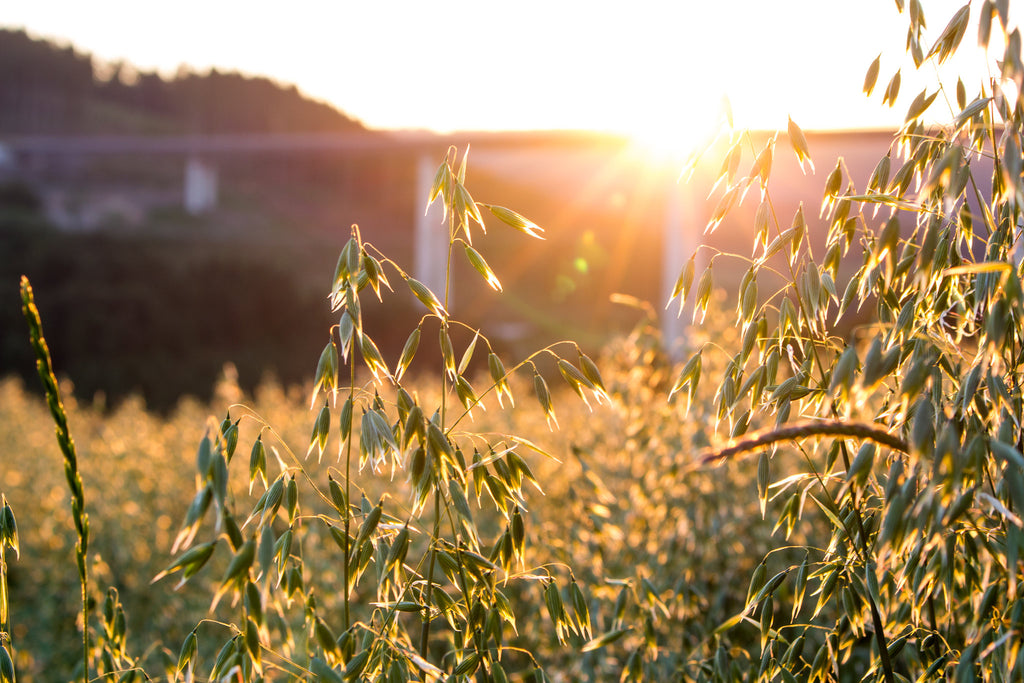An exciting new addition to the Siskiyou Seeds collection is the various cover crop seeds now available. Amongst them, a truly versatile plant, the Oat. In Avena sativa, which easily translates from Latin into cultivated oat, we find a great companion for the garden. A cover crop, food and fodder for human and animals and also a wonderful and adaptive plant medicine.

Oats make an excellent companion to peas in cover crops and emphasize the ability for peas to fix nitrogen in the soil. They grow quickly, help with erosion control and enjoy the cold moist seasons. Oats can be surface sown in the fall or early spring for an excellent soil building weed suppressant in your garden. Avena sativa is a tufted grass with a fibrous root in the Poacea family and can grow to be about 5 feet tall. It takes about a week to germinate and will fruit in 100 days in the Spring or about 270 days if Autumn sown.
The part that you are probably most acquainted with is likely the kernel of which the end result is oatmeal! Mature oat seed is harvested and made into whole oats, rolled oats, oat milk and many other nourishing products. Oats are often fed to animals both the green grass, hay and the seed. The part used in herbal medicine is the fresh milky immature oat seed. It is in optimum stage for medicine making when immature and you can take the oat kernel between your fingers and squeeze a “milky” white exudate from the endosperm.
Humans have been cultivating oats for a thousand of years with good reason and it would take much more than a short post to exalt the many benefits of the addition of oats to your diet and to your garden. Some of the most notable are that oats are high in amino acids, vitamins and soluble fiber, they contain high levels of lysine and have anti-oxidant properties to help prevent free radicals in your body from damaging your DNA. Oats contain B-glucan which is said to help lower cholesterol and blood pressure. Oats can also improve insulin function and normalize blood glucose. As oats are a food, the medicine made from them is gentle and nourishing to many body systems. They are considered to be helpful with anxiety, a true tonic to the nervous system. Milky oats can be made into a tea or tincture or decoction.
This year I will definitely be adding oats to my cover crop program. Eliot Coleman recommends under sowing oats with tomatoes in his “New Organic Gardener”. Usually for cover crop you would want to crimp, mow or let your animals chew down the grass before it goes to seed. If you want to grow oats as a cover crop and for medicine making I would recommend leaving part of your cover crop standing so you can harvest the milky oats when they are ready. It you have a small space that you are cover cropping you could leave all of it to go to seed and then be sure to harvest the milky oats before they mature. Oats are prolific and you want to make sure to not let them go to seed. They are safe to use for people and the issue of gluten contamination with factory processed oats is not a problem with home grown oats.
≈ by Taryn Hunter
Citations
Al-Snafi, Ali Esmail. “THE NUTRITIONAL AND THERAPEUTIC IMPORTANCE OF AVENA SATIVA - AN OVERVIEW.” International Journal of Phytotherapy, vol. 5, no. 1, 2015, pp. 48–56. research gate, www.researchgate.net/publication/313664348_The_nutritional_and_therapeutic_importance_of_Avena_sativa_-_An_Overview.
Assefa, G., 2006. Avena sativa L. In: Brink, M. & Belay, G. (Editors). PROTA (Plant Resources of Tropical Africa / Resources végétales de l’Afrique tropicale), Wageningen, Netherlands. Accessed 12 November 2020.
"Avena sativa (PROTA)." PlantUse English, . 25 Aug 2015, 17:29 UTC. 21 Mar 2021, 02:36 <https://uses.plantnet-project.org/e/index.php?title=Avena_sativa_(PROTA)&oldid=198506>.
Coleman, Eliot, 1938-. The New Organic Grower : a Master's Manual of Tools and Techniques for the Home and Market Gardener. White River Junction, Vt. :Chelsea Green Pub. Co., 1995.


Nancy Sutton
Thank you so much for this interesting and timely information. I am planning on growing some ‘hulless’ oats… for weed suppression, chickens and me ;) Better get some in the ground now! :)